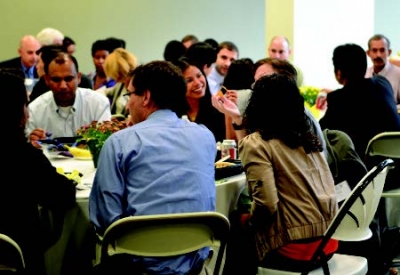On September 21-22, 2012, Harvard Ophthalmology hosted its 2nd Biennial International Symposium on age-related macular degeneration (AMD), which spurred lively discussion and debate among more than 200 clinicians, researchers, and trainees in attendance. A diverse and distinguished group of AMD experts from around the world engaged in stimulating and open-ended panel discussions on a wide array of AMD topics that included RPE/Bruch’s membrane/choriocapillaris, infl ammation, lipids/cardiovascular disease, imaging, angiogenesis beyond VEGF, neuroprotection/ regeneration, drug delivery, and neurodegenerative diseases.
The meeting drew highly favorable reviews from participants who commented on the caliber of speakers, depth of discussion, and opportunity for exchange. One participant noted, “Panel sessions were really thought-provoking and the highlight of the meeting.” Another commented, “Best AMD symposium…enjoyed inclusion of other disease modalities in thinking how they might overlap with AMD pathophysiology.” While a third participant noted, “I was... struck by the number of passionate physician scientists trying to solve the problem!” The symposium format was purposely modeled after the highly successful inaugural meeting held in 2010, which began an important and intense dialogue around current AMD topics and the challenges that lay ahead. This year’s symposium, co-directed by Patricia D’Amore, PhD, MBA, FARVO, Ivana Kim, MD, and HMS Ophthalmology Chair, Joan W. Miller, MD, FARVO, sought to build on this momentum.
 The unique format engaged participants in discussion and brainstorming, with the goal of building collaborations among AMD colleagues. Another unique aspect of the meeting was the participation of experts from disciplines outside of AMD whose research shed insight on other multiple target pathways that could potentially drive advancements in the field. Discussions were facilitated by a distinguished group of panelists and moderators.
The unique format engaged participants in discussion and brainstorming, with the goal of building collaborations among AMD colleagues. Another unique aspect of the meeting was the participation of experts from disciplines outside of AMD whose research shed insight on other multiple target pathways that could potentially drive advancements in the field. Discussions were facilitated by a distinguished group of panelists and moderators.
Participants debated several “hot” topics during the course of the symposium. One intense discussion – and a recurring theme throughout the meeting – focused on the potential epidemiological link between lipid deposition and the development of AMD. Another point of debate centered on whether impairment of rod-mediated (dark adaptation) vision is an early change in AMD that might form the basis of an early diagnostic test for the disease. A point of discussion on which participants unanimously agreed was that the field of ophthalmology will be the epicenter for future success in genomics and gene therapy.
Over the last two decades, a group of Harvard Ophthalmology clinician scientists led intensive research efforts in AMD that helped fuel a revolution in patient care, and has saved the sight of millions worldwide. In her opening remarks, Dr. Miller noted, “Collectively, we’ve reached important milestones in AMD medicine and science, but much work remains if we are to permanently eradicate retinal diseases like AMD. With current momentum in fields of study such as genetics, neuroprotection, and regeneration, we are poised to make surefire advances over the next decade. It’s this momentum that we need to leverage, and the genesis for this meeting. Future and rapid advancements in the field will require collaboration and a multidisciplinary approach on an international scale. Our goal here is to bring together the multidisciplinary expertise of our attendees and launch the innovative ideas that take us to the next level.
